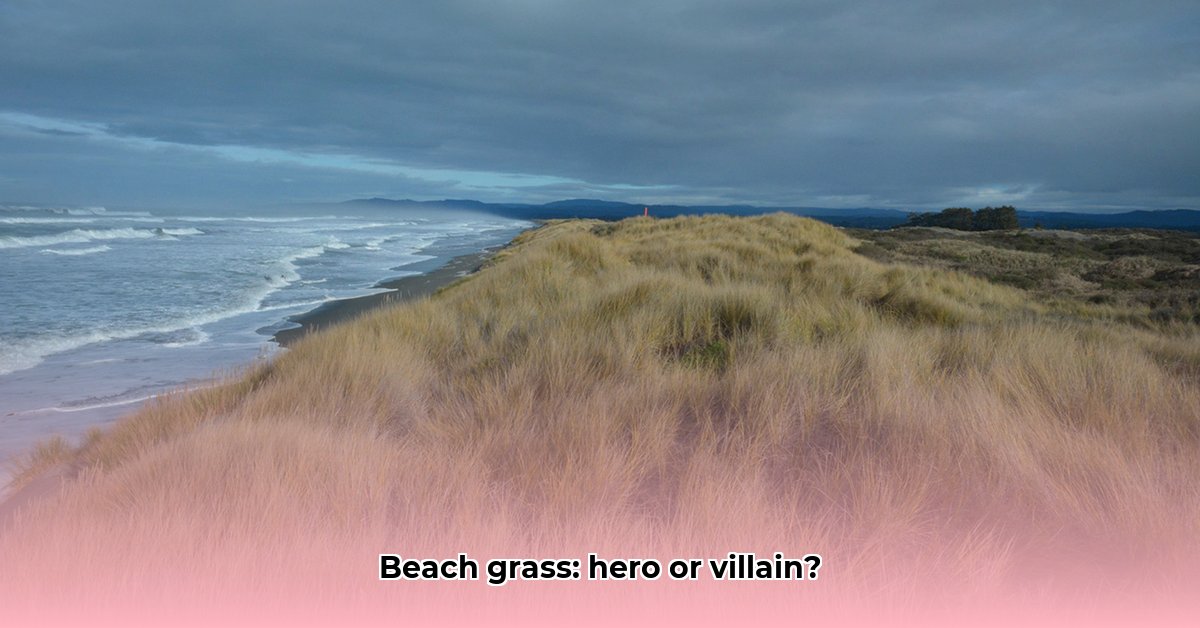Introduction: A Coastal Conundrum
American beachgrass (Ammophila breviligulata) stands as a critical component of coastal ecosystems, offering invaluable dune stabilization against the relentless forces of erosion. Its extensive rhizome system and vigorous growth effectively trap sand, fortifying dunes against wind and waves. However, this very strength presents a potential ecological challenge: invasiveness. This comprehensive guide delves into the complex duality of American beachgrass, exploring its benefits, potential risks, and the strategies required for responsible coastal management.
Understanding American Beachgrass: Biology, Ecology, and Planting
To effectively manage American beachgrass, a deep understanding of its biological and ecological characteristics is essential. A. breviligulata thrives in harsh coastal conditions, tolerating salt spray, powerful winds, and drought. It propagates through both rhizomes and seeds, with planting plugs (sections of established grass) often the preferred method for rapid establishment and erosion control. Plugs offer a significant advantage over seeds, providing a head start that allows for faster dune stabilization. Specifically, plugs bypass the vulnerable seedling stage, allowing the grass to establish a robust root system and begin sand accretion more rapidly. This rapid growth is crucial in areas experiencing active erosion.
Seed germination, while possible, can be unreliable due to factors like fluctuating temperatures and salinity. Furthermore, seed dispersal often results in uneven distribution, while plugs offer controlled placement for optimal coverage. Understanding these propagation nuances is crucial for successful dune management.
American vs. European Beachgrass: A Comparative Analysis
Comparing American beachgrass (A. breviligulata) to its European counterpart (Ammophila arenaria) provides valuable insights into dune building strategies and their ecological implications. While both species are effective sand stabilizers, they exhibit key differences. A. arenaria often forms taller dunes, potentially altering coastal landscapes more dramatically. However, A. breviligulata, while generally less aggressive in its native range, can exhibit invasive tendencies in non-native environments.
The choice between these two species for dune restoration requires careful consideration of the specific location and desired outcomes. Factors like native plant communities, existing dune structure, and long-term management goals must be thoroughly evaluated. For instance, areas with sensitive native flora may benefit from the less aggressive nature of A. breviligulata in its native range, while areas with severe erosion might require the more robust dune-building capacity of A. arenaria, with careful monitoring for invasiveness.
Invasive Potential and Management of Ammophila breviligulata
While A. breviligulata plays a crucial role in dune stabilization along the eastern US coast, its introduction to other regions has demonstrated invasive potential. The plant’s rapid growth can outcompete native vegetation, resulting in a decline in biodiversity and alterations to habitat structure. Specifically, the dense rhizome network of A. breviligulata can effectively monopolize resources, making it difficult for native plants to establish or survive. This can lead to simplified plant communities and a loss of habitat complexity, impacting dependent animal species.
Managing the invasive potential of A. breviligulata necessitates a multi-faceted approach. Early detection and rapid response are crucial. Mechanical removal, including digging and uprooting, can be effective for small infestations. For larger infestations, chemical control methods, using herbicides targeted at grasses, might be necessary, but should be employed with careful consideration for non-target impacts. Controlled burns, implemented strategically, can also be effective, particularly in areas where the native vegetation is adapted to fire regimes. Long-term monitoring and adaptive management strategies are essential for successful invasive species control.
Actionable Strategies for Sustainable Dune Management
Sustainable dune management requires a collaborative effort among coastal managers, landowners, researchers, and local communities. Here are key recommendations:
- Comprehensive Site Assessment: Before initiating any planting project, conduct a detailed assessment of the existing ecosystem. This includes identifying native plant communities, analyzing soil characteristics (texture, nutrient content, salinity), evaluating current erosion patterns, and understanding prevailing environmental conditions (wind direction, wave action, tidal influence).
- Strategic Planting Techniques: Utilize plugs for rapid establishment and erosion control. Employ optimal spacing based on site-specific factors, balancing the need for quick coverage with the potential for overcrowding. Monitor growth regularly and adjust planting strategies as needed. This might involve thinning dense patches to prevent excessive competition or supplementing with native species to enhance biodiversity.
- Proactive Invasive Species Management: Implement regular monitoring programs to detect any invasive growth of A. breviligulata early on. If detected, utilize appropriate control methods, ranging from manual removal to chemical control or prescribed burning. Carefully consider potential impacts on non-target species and the surrounding environment when selecting control methods.
- Collaborative Research and Adaptive Management: Foster communication and collaboration among all stakeholders. Support ongoing research to refine management strategies, deepen our understanding of A. breviligulata’s ecology, and improve predictive models for its invasive potential. Embrace adaptive management principles, continually evaluating management effectiveness and adjusting strategies based on new information and observed outcomes.
Conclusion: A Holistic Approach to Dune Management
American beachgrass offers invaluable benefits for coastal protection, but its invasive potential requires careful consideration and proactive management. A holistic approach, grounded in scientific understanding and collaboration, is essential for harnessing the positive attributes of A. breviligulata while mitigating its risks. By integrating comprehensive site assessments, strategic planting techniques, proactive invasive species management, and ongoing research with adaptive management principles, we can effectively stabilize our dunes while safeguarding the long-term health and biodiversity of our coastal ecosystems.









